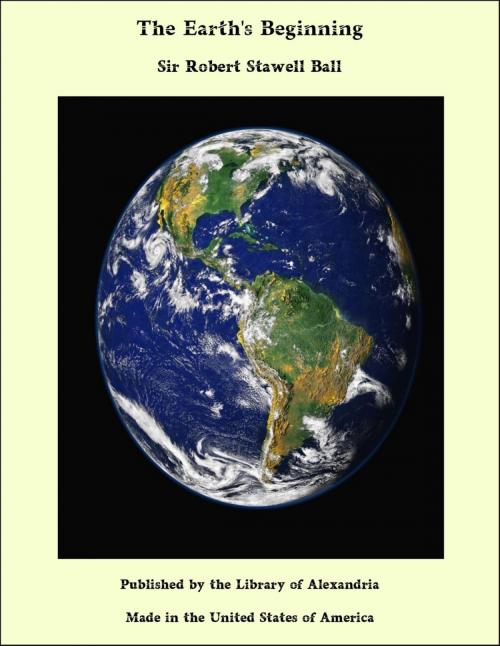| Author: | Sir Robert Stawell Ball | ISBN: | 9781465626202 |
| Publisher: | Library of Alexandria | Publication: | March 8, 2015 |
| Imprint: | Language: | English |
| Author: | Sir Robert Stawell Ball |
| ISBN: | 9781465626202 |
| Publisher: | Library of Alexandria |
| Publication: | March 8, 2015 |
| Imprint: | |
| Language: | English |
I TRY in these lectures to give some account of an exceptionally great subject—a subject, I ought rather to say, of sublime magnificence. It may, I believe, be affirmed without exaggeration that the theme which is to occupy our attention represents the most daring height to which the human intellect has ever ventured to soar in its efforts to understand the great operations of Nature. The earth’s beginning relates to phenomena of such magnitude and importance that the temporary concerns which usually engage our thoughts must be forgotten in its presence. Our personal affairs, the affairs of the nation, and of the empire—indeed, of all nations and of all empires—nay, even all human affairs, past, present, and to come, shrink into utter insignificance when we are to consider the majestic subject of the evolution of that solar system of which our earth forms a part. We shall obtain a glimpse of what that evolution has been in the mighty chapter of the book of Nature on which we are now to enter. The nebular theory discloses the beginning of this earth itself. It points out the marvellous process by which from original chaos the firm globe on which we stand was gradually evolved. It shows how the foundations of this solid earth have been laid, and how it is that we have land to tread on and air to breathe. But the subject has a scope far wider than merely in its relation to our earth. The nebular theory accounts for the beginning of that great and glorious orb the sun, which presides over the system of revolving planets, guides them in their paths, illuminates them with its light, and stimulates the activities of their inhabitants with its genial warmth. The nebular theory explains how it comes about that the sun still continues in these latter days to shine with the brilliance and warmth that it had throughout the past ages of human history and the vastly greater periods of geological time. Then, as another supreme achievement, it discloses the origin of the planets which accompany the sun, and shows how they have come to run their mighty courses; and it tells us how revolving satellites have been associated with the planets. The nebular theory has, indeed, a remarkable relation to all objects belonging to that wonderful scheme which we call the solar system. It should also be noticed that the nebular theory often brings facts of the most diverse character into striking apposition. As it accounts for the continued maintenance of the solar radiation, so it also accounts for that beneficent rotation by which each continent, after the enjoyment of a day under the invigorating rays of the sun, passes in due alternation into the repose of night. The nebular theory is ready with an explanation of the marvellous structure revealed in the rings of Saturn, and it shows at the same time how the volcanoes of the moon acquired their past phenomenal activity, and why, after ages of activity, they have now at last become extinct. With equal versatility the nebular theory will explain why a collier experiences increasing heat as he descends the coalpit, and why the planet Jupiter is marked with those belts which have so much interest for the astronomer. The nebular theory offers an immediate explanation of the earthquake which wrought such awful destruction at Lisbon, while it also points out the cause of that healing warmth of the waters at Bath. Above all, the nebular theory explains that peerless discovery of cosmical chemistry which declares that those particular elements of which the sun is composed are no other than the elements which form the earth beneath our feet.
I TRY in these lectures to give some account of an exceptionally great subject—a subject, I ought rather to say, of sublime magnificence. It may, I believe, be affirmed without exaggeration that the theme which is to occupy our attention represents the most daring height to which the human intellect has ever ventured to soar in its efforts to understand the great operations of Nature. The earth’s beginning relates to phenomena of such magnitude and importance that the temporary concerns which usually engage our thoughts must be forgotten in its presence. Our personal affairs, the affairs of the nation, and of the empire—indeed, of all nations and of all empires—nay, even all human affairs, past, present, and to come, shrink into utter insignificance when we are to consider the majestic subject of the evolution of that solar system of which our earth forms a part. We shall obtain a glimpse of what that evolution has been in the mighty chapter of the book of Nature on which we are now to enter. The nebular theory discloses the beginning of this earth itself. It points out the marvellous process by which from original chaos the firm globe on which we stand was gradually evolved. It shows how the foundations of this solid earth have been laid, and how it is that we have land to tread on and air to breathe. But the subject has a scope far wider than merely in its relation to our earth. The nebular theory accounts for the beginning of that great and glorious orb the sun, which presides over the system of revolving planets, guides them in their paths, illuminates them with its light, and stimulates the activities of their inhabitants with its genial warmth. The nebular theory explains how it comes about that the sun still continues in these latter days to shine with the brilliance and warmth that it had throughout the past ages of human history and the vastly greater periods of geological time. Then, as another supreme achievement, it discloses the origin of the planets which accompany the sun, and shows how they have come to run their mighty courses; and it tells us how revolving satellites have been associated with the planets. The nebular theory has, indeed, a remarkable relation to all objects belonging to that wonderful scheme which we call the solar system. It should also be noticed that the nebular theory often brings facts of the most diverse character into striking apposition. As it accounts for the continued maintenance of the solar radiation, so it also accounts for that beneficent rotation by which each continent, after the enjoyment of a day under the invigorating rays of the sun, passes in due alternation into the repose of night. The nebular theory is ready with an explanation of the marvellous structure revealed in the rings of Saturn, and it shows at the same time how the volcanoes of the moon acquired their past phenomenal activity, and why, after ages of activity, they have now at last become extinct. With equal versatility the nebular theory will explain why a collier experiences increasing heat as he descends the coalpit, and why the planet Jupiter is marked with those belts which have so much interest for the astronomer. The nebular theory offers an immediate explanation of the earthquake which wrought such awful destruction at Lisbon, while it also points out the cause of that healing warmth of the waters at Bath. Above all, the nebular theory explains that peerless discovery of cosmical chemistry which declares that those particular elements of which the sun is composed are no other than the elements which form the earth beneath our feet.















